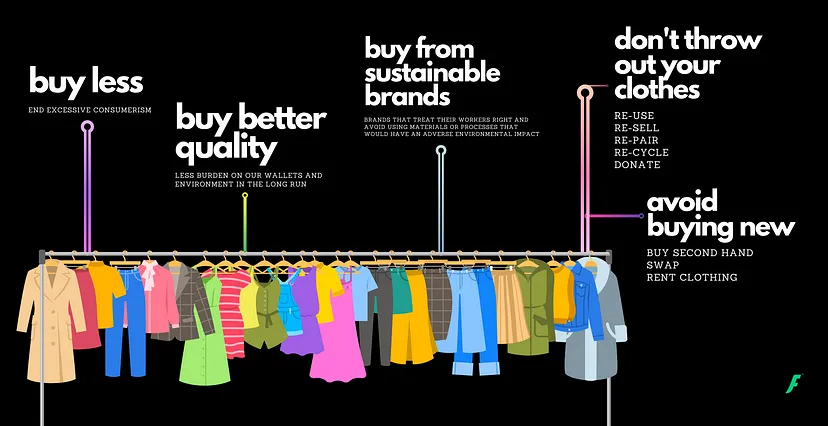We are sprinting towards unsustainability with Fast Fashion

Wish we could keep up with climate action, as passionately as we keep up with fashion trends.
Fast fashion stems from our excessive consumerism. As the name suggests, 'fast fashion' can be defined as cheap, mass-produced garments that are pumped swiftly into the market in order to maximize on current trends. The 'fast' in fast fashion is applied to the designing, producing, marketing, and distributing processes of the industry. On top of that the price range of these apparels are exceedingly low.
The entire cycle of designing to delivery has a record time of two weeks, reached in 2012 by a famous brand.
This availability of variety, affordability, and convenience has led to excessive consumerism. 400% more clothes are produced now as compared to 20 years ago. And as the durability of these cheap, mass-produced clothing are questionable, they frequently end up in trashcans. Consequently, the world is producing 92 million tons of textile waste each year.
Synthetic fibers such as polyester, are plastic fibers, therefore non-biodegradable and can take up to 200 years to decompose.
To make clothes at low cost, there has been a substantial increase in non-biodegradable fabrics and chemical use. Unsurprisingly, fashion industry is the second largest polluter globally after the oil industry. Apart from polluting landfills the industry is inevitably polluting our oceans too, via discharge of chemicals and microfibers.
While washing a synthetic garment, about 700,000 individual microfibres are released into the water, making their way to the ocean.
Small aquatic organisms ingest those microfibers and are eventually introduced in our food chain. These synthetic fibers are not only contaminating our water bodies but also air. According to a study one person could release approximately 900 million microfibers per year to the air by simply wearing the garments. Well looks like we are breathing plastic too.
Talking about the raw materials needed, 1.5 trillion liters of water are used by the fashion industry per year. At the same time, 750 million people in the world do not have access to drinking water.
Additionally, toxic untreated wastewater containing lead, mercury and arsenic are also released into the water bodies, inevitably risking aquatic and human life.
Continuing with environmental implications of fast fashion; 70 million trees are cut down each year to make wood-based fibers like rayon. And 70 million oil brands are used every year just to produce polyester. Needless to say, greenhouse gas emissions, like CO2 and NO2 are exceedingly high, contributing to global warming.
Fashion industry is responsible for 4 percent of the world's greenhouse-gas emissions.
Environmental impacts are not the only concerns with the industry. Social impacts are as daunting. Every step of production involves toxic chemicals, posing a health hazard for the workers of the industry as well as the end consumers.
Further, the working conditions of the people in this industry are hardly ever adequate. Most of our clothes are made in countries where labour rights are limited or outright non-existent. Minimum wage is a dream and working hours are insane. Often, they are forced to work for 14-16 hours a day, 7 days a week to meet unattainable deadlines.
Employees usually work with no ventilation, inhaling fiber dust, fumes, or blasted sand in poorly constructed or old unsafe buildings. Accidents, fires, injuries, and disease are very frequent occurrences on textile production sites.
In 2013, the collapse of Rana Plaza killed 1134 garment workers in Dhaka, Bangladesh.
On top of that, children are forced to work in such places. And unionization as an option is actively expropriated from them.
As we can discern, rapid production has led to reckless production. Fashion industry's economic projections are their supreme concern. Hence, the welfare of people and environmental concerns have taken a back-seat.
The industry needs to hit brakes on excessive and mindless production. From designing to delivery, each step needs to become more sustainable and way slower. We could call it “Slow Fashion”.
But, as the root of the problem lies in our excessive consumerism, we need to become conscious consumers as well.
Buy clothes from sustainable brands of countries where the manufacturing industry is powered by more renewable energy. Also, make sure the brands that you are buying from, treats their workers right.
Synthetic fibers are used in 72% of our clothing. Given the pollution statistics just switching to greener materials would make a lot of positive changes. But even the greenest garment brands use resources for production and transport, creating some environmental impact.
Ergo buy less and before throwing away your clothes, consider reusing, reselling, repairing, recycling, or donating. On the other end of the spectrum, choose to buy second hand, try swapping clothes, or opt for renting apparels.

Thankfully more and more fashion brands are now taking into account the environmental and social impact of their production while maintaining their affordability. Excitingly, many consumers are also educating themselves and others about the drawbacks of fast fashion and are opting out from being a part of it.
To make up for the harm already induced by the textile industry, we could become more active for propagating global goals. FloCard contributes to all 17 of the global goals laid down by the UNDP . It is an innovation with an array of values lying in sustainability.
If you are enthusiastic about climate action and social development like us, then join our “Better Planet Together” movement by making your free FloCard today.
Follow us on LinkedIn, Twitter, Instagram and Facebook to know more about our campaign and to stay motivated for action.
